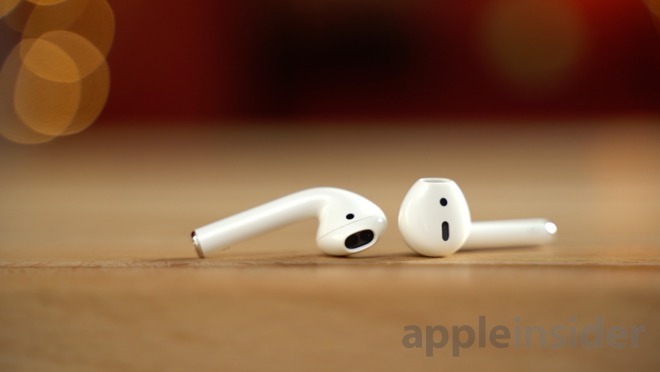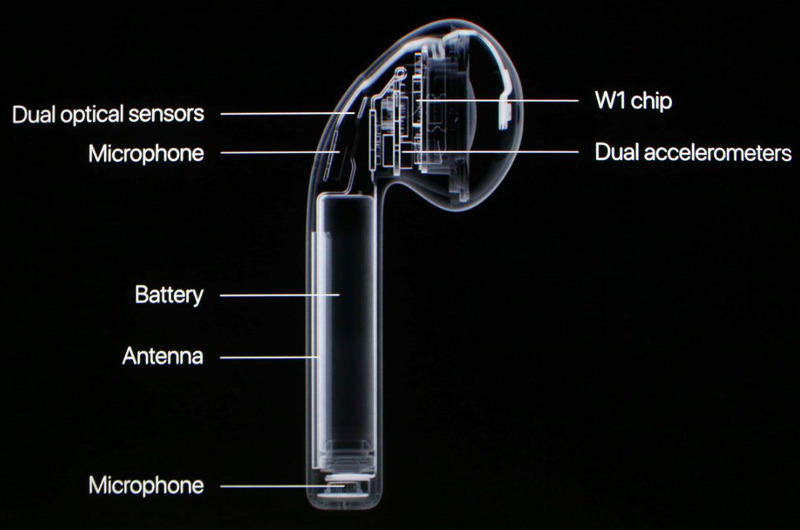Over the last month, a UK tabloid and the Medium blogging platform helped launch a wave of articles later syndicated by Yahoo and other clickbait sites implying that large group of scientists were very concerned about the health risks of AirPods. The problem: the petition was signed in early 2015, before AirPods were even announced. Its concerns were not linked to the extremely weak Bluetooth Low Energy protocol that AirPods use.
A petition for more research
The 2015 petition related to Electromagnetic Field Exposure, signed by scientists, was addressed to the World Health Organization and member nations of the UN. It cited "serious concerns regarding the ubiquitous and increasing exposure to EMF generated by electric and wireless devices."
Rather than specifically citing AirPods, which didn't even yet exist, the petition stated that "these include-but are not limited to-radio frequency radiation (RFR) emitting devices, such as cellular and cordless phones and their base stations, Wi-Fi, broadcast antennas, smart meters, and baby monitors as well as electric devices and infra-structures used in the delivery of electricity that generate extremely-low frequency electromagnetic field (ELF EMF)."
The petition acknowledged that the WHO and member nations had established guidelines for exposure to EMF radiation back in 1998 developed by the International Commission on Non-Ionizing Radiation Protection. Ten years later, that agency revisited its rules and stated its opinion that "the scientific literature published since that time has provided no evidence of any adverse effects below the basic restrictions" it had outlined.
In 2002 and 2011, the WHO adopted classifications by International Agency for Research on Cancer that EMF is a "possible human carcinogen (Group 2B)", a category that includes carbon black, cobalt, ginkgo biloba, and nickel. However, regarding EMF it also noted "insufficient evidence to justify lowering these quantitative exposure limits" in its regulations.
The petition noted "it is our opinion that, because the ICNIRP guidelines do not cover long-term exposure and low-intensity effects, they are insufficient to protect public health." It further stated that "since there is controversy about a rationale for setting standards to avoid adverse health effects, we recommend that the United Nations Environmental Programme (UNEP) convene and fund an independent multidisciplinary committee to explore the pros and cons of alternatives to current practices that could substantially lower human exposures to RF and ELF fields."
So rather than finding any link between cancer or other issues in levels of EMF at or below the current, accepted regulations, the scientists involved here were simply asking for more research into to area and suggested that it was probably a good idea to limit human exposure. They were also taking issue with the findings of other scientists and a decade of scientific literature that indicated that there was "no evidence of any adverse effects below the basic restrictions" already in place.
From EMF concerns to AirPods clickbait
Various bloggers picked up the subject and worked to associate it with Apple's AirPods. Natalie Rahhal, the "Deputy Health Editor" of the UK's sensationalist tabloid Daily Mail, kicked things off with the headline "Are AirPods dangerous? 250 scientists sign petition warning against cancer from wireless tech including the trendy in-ear headphones," without regard for the fact that nothing in the petition even suggested concern about in-ear headphones, Bluetooth, or AirPods.
The petition was updated in January 2019, with no mention of Bluetooth or AirPods being added, despite three years of prominent sales as a standout hit in wearables using wireless technology.
Rob Waugh, a "contributor" for Yahoo News UK penned a piece headlined, "Wireless headphones like Apple AirPods could pose cancer risk', scientists warn." Except that the truth was that these scientists were not warning that "wireless headphones" were a cancer risk. Yahoo was making that up and spreading it for ad clicks.
AirPods clearly became central to the story to gain attention, with the Daily Mail prominently noting "Apple sold 29 million pairs of AirPods." Yet the devices actually cited by the petitioning scientists in question were not AirPods nor even Bluetooth wearables, but rather cordless phones, cellular phones, WiFi devices, and power delivery infrastructure.
Yet across the last decade, we haven't seen any evidence that the EMF these devices use has any significant association with cellular damage or cancer— two things that we do know are quite clearly associated with other behaviors, from eating meat to going outside in the sun.
Misleading reports by tabloids have also fueled claimed that there have not been any recent studies that have specifically looked at modern consumer use of EMF generating products like mobile phones and wireless earbuds. But that's not true. US Food and Drug Administration has been running studies for 15 years on the topic.
And internationally, scientists looking at the data have repeatedly established that there was no data supporting the idea that existing limits should be lowered for safety reasons, as the petition signers above acknowledged.
EMF risk assessment should be based on real data
Since the WHO regulations were codified in 1998 and ratified in 2009, there have been billions of cellular phones in constant use around the world, using far higher powered EMF than AirPods can produce.
Anywhere you can reach a WiFi or cellular signal or can feel the sun on your skin, you're getting far more EMF exposure than having AirPods in your ears.
We know this because WiFi and Bluetooth use the same radio frequencies, but at wildly different intensities. Carrying the same data payload, WiFi uses about 40 milliwatts of power at the same rate as Bluetooth does broadcasting just 1 mW. That's of course why Bluetooth can lose its signal in a few feet, while WiFi can blast through walls and around your entire house.
In the case of sunlight, you're also exposed to ionizing radiation, the type that is actually known to cause cancer and other damage. The radio energy produced by electronics like AirPods is non-ionizing.
And while AirPods do fit into the soft tissues of your ear canal and are intended to sit in contact for hours of constant use, that's not some entirely new application of Bluetooth. Previous generations of far less efficient Bluetooth headphones and phone headsets broadcasting at higher power have been in use for a decade. If there were some credible link between soft tissues and Bluetooth wearables, we should have the data showing that.
Lowering EMF standards would have the side effect of making devices work less effectively, so there should be data driving the decision rather than just a hunch or speculation of possibility. At the same time, the industry is already working increase efficiency using lower EMF simply because that also improves battery life.
Bluetooth is rapidly getting better with less EMF
Apple wasn't the first to market when it released its own Bluetooth Headset back in 2007 for the original iPhone. And that product used far more power to operate, begin based on Bluetooth 2.0. That version of the standard had a maximum permitted power of 2.5 mW.
The more modern Bluetooth 4.1 Low Energy (BLE) protocol used by today's AirPods isn't just a minor update, it's an entirely different technology stack based on Wibree and simply rebranded as Bluetooth for marketing reasons. The maximum permitted power of AirPod's BLE is just 0.5 mW, a fifth of what Bluetooth used just ten years ago.
Further, Apple has optimized the highly efficient use of AAC codecs using advanced psychoacoustics to deliver audio to your ears as efficiently as possible, so the devices are not running at full power.
It didn't do this primarily to make AirPods a "health device," but the side effect of squeezing as much performance as possible using as little power as possible makes AirPods one of the smallest sources of EMF we ever interact with on a daily basis, even though they're worn in the ear canal.
Apple Watch uses WiFi and Bluetooth, and is strapped to your wrist all the time. iPhones use both as well as mobile radios, and are typically in your pocket right up against your leg most of the time. Apple's WiFi "maximum output power" on iPhone 5 was reported on FCC filings to be between about 130 and 315 mW.
In the United States, WiFi base stations can legally broadcast at 1000 mW to 1500 mW, although most modern units work at around 28 mW. So WiFi itself involves many times stronger EMF than the BLE used by AirPods. That is reflected in the Specific Absorption Rate (SAR), a measurement of the amount of emitted radiation absorbed by your body. For AirPods, it's 0.466 watts per kilogram, or about a quarter of U.S. Federal Communications Commission regulatory limit of 1.60 w/kg. For iPhone 7, the SAR is 1.58 w/kg when against your head or body, and actively broadcasting at full power with both Wi-Fi and the LTE radio.
That suggests that using AirPods to answer calls involves dramatically less exposure to EMF than holding your phone to your ear. Further, the Bluetooth antennas in AirPods are not the part inserted into your ear canal. Their antennas run parallel to the battery and microphones on the exterior side of the segments that hang out of your ears.
When you open up WiFi settings and your phone can detect a dozen or more various networks, that demonstrates that you are effectively always bathing in the same EMF frequencies used by BLE, except at higher intensities than AirPods can produce. And even WiFi networks are not the strongest EMF sources we're exposed to on a regular basis.
So writing about the "cancer threat of AirPods" is as asinine as being concerned about the potential of cancer risk from your nickel bracelet while laying in the sun smoking cigarettes.
Apple's latest wearables were not the subject of the petition asking the WHO to keep studying the effect of EMF. And that petition itself was effectively speculating that there could be some impact that we just haven't seen over the past decade of much more intense sources of EMF-related to WiFi and other radio devices that are not new.
We should certainly continue to study the effects of EMF on human tissue. This subject is of particular interest to Apple, given that it currently effectively owns the markets for wearable audio devices and for other wearable radio devices like Apple Watch. But raising alarm about issues that lack any supporting evidence draws attention away from issues that are real.
 Daniel Eran Dilger
Daniel Eran Dilger









-m.jpg)






 Christine McKee
Christine McKee
 Marko Zivkovic
Marko Zivkovic
 Mike Wuerthele
Mike Wuerthele

 Amber Neely
Amber Neely
 Sponsored Content
Sponsored Content
 Wesley Hilliard
Wesley Hilliard










47 Comments
Wireless gadget close to body including Smartphone can cause cancer debate going on for over decade. We will find in one more decade if the number of head related cancer increases.
Wikipedia considers The Daily Mail to be an unreliable source and is banned from being used as the sole source for citations.
Sadly, it’s also a popular newspaper in the UK and it’s online equivalent - which has even lower editorial standards - is one of the most popular news websites on the planet.
As soon as I read "UK tabloid" in the opening line I knew this was going to refer to the "DailyMail"... or "Daily Fail" as many in the UK like to call it. It isn't the worst of the 'gutter press' titles in the UK which probably accounts for it being Britain's second biggest newspaper by readership.
However, as is no doubt correctly implied in it's Wikipedia entry, "
Enough said!
Hmm...DED’s article is the first I heard about this. Clearly the clickbait didn’t work.